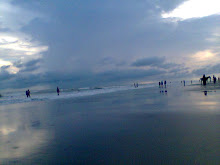
But the most significant Buddhist image, belonging however to the early eleventh century, comes from Mainamati-Dedvaparvata (fig 13). The image in bronze is a colossal representation of the Bodhisattva-Vajrasattva, being 1.5 m high even in sitting position. It is the largest and possibly the best-preserved metal sculpture so far discovered in eastern India. In its anatomical proportions of the body, balanced pose of the hands and perfect geometrical composition the Vajrasattva is a remarkable creation, combining in one the previous experiences of Nalanda and Jhewari. With equal emphasis on plain surface, as of the body, and ornamentation, as of the crown and pendent earrings, the image stands between the classical and medieval ideals. It is one of the supreme expressions of Bengal's plastic art. From a contemporary bronze head of a life-size Bodhisattva-Avalokiteshvara image from the same site it seems that the Mainamati artist was a master in the cire perdue or hollow casting technique of bronze.
While the ninth and tenth century Pala sculptures thrived on the ideals of the Gupta classical art, from the eleventh century the art of Bengal began to show marked stylistic changes by introducing new features on the persons of the deities and their pedestals and aureoles. Though not divorced from the experiences of the two preceding centuries, they actually evolved a new aesthetic vision which has been termed the "medieval style" in the parlance of the art historians. The sculptures of the style relied more on decorative elements than the principal objects, and as a result they became more and more overwhelmed by the increasing number of subsidiary figures, boldly carved ornaments on them and multitude of motifs on pedestals and aureoles, especially as time passed from the eleventh to the twelfth century.
The bronzes of the eleventh century represent the medieval style in its early maturity, by exhibiting dexterously cast and chiselled figures and decorative elements. For instance, the crowned Buddha images, standing in protecting gesture on a double-petalled lotus based on a pancharartha pedestal and surrounded by an halo with stylized flame-motifs all along on its border, provide an archetype for the images of medieval Bengal style. What is significant is that the Buddha-type as evolved in the days of Vigrahapala III in south Bihar set norms also for the Vishnus in bronze found from different parts of Bengal proper. Two bronze Vishnus, both of the eleventh century and now in the Asutosh Museum, one from Sagardhighi in Murshidabad district and the other from Rangpur in north Bengal, may be cited as examples. But still more interesting is a silver Visnu from Sonarang in Vikrampur, Bangladesh, now in the Indian Museum, showing more elaborate and complicated decorative elements achieved in a skill rare even among the immaculately executed metal images of eastern India. (13 of 16)
While the ninth and tenth century Pala sculptures thrived on the ideals of the Gupta classical art, from the eleventh century the art of Bengal began to show marked stylistic changes by introducing new features on the persons of the deities and their pedestals and aureoles. Though not divorced from the experiences of the two preceding centuries, they actually evolved a new aesthetic vision which has been termed the "medieval style" in the parlance of the art historians. The sculptures of the style relied more on decorative elements than the principal objects, and as a result they became more and more overwhelmed by the increasing number of subsidiary figures, boldly carved ornaments on them and multitude of motifs on pedestals and aureoles, especially as time passed from the eleventh to the twelfth century.
The bronzes of the eleventh century represent the medieval style in its early maturity, by exhibiting dexterously cast and chiselled figures and decorative elements. For instance, the crowned Buddha images, standing in protecting gesture on a double-petalled lotus based on a pancharartha pedestal and surrounded by an halo with stylized flame-motifs all along on its border, provide an archetype for the images of medieval Bengal style. What is significant is that the Buddha-type as evolved in the days of Vigrahapala III in south Bihar set norms also for the Vishnus in bronze found from different parts of Bengal proper. Two bronze Vishnus, both of the eleventh century and now in the Asutosh Museum, one from Sagardhighi in Murshidabad district and the other from Rangpur in north Bengal, may be cited as examples. But still more interesting is a silver Visnu from Sonarang in Vikrampur, Bangladesh, now in the Indian Museum, showing more elaborate and complicated decorative elements achieved in a skill rare even among the immaculately executed metal images of eastern India. (13 of 16)

No comments:
Post a Comment